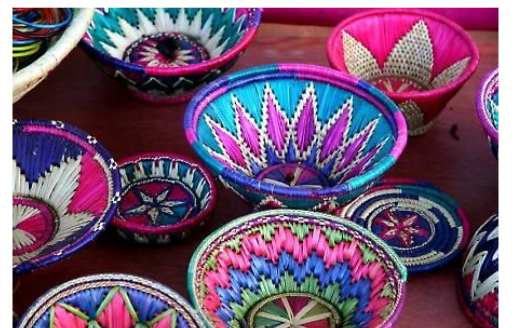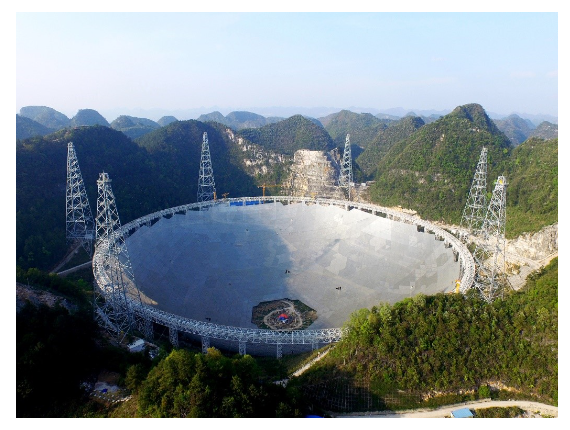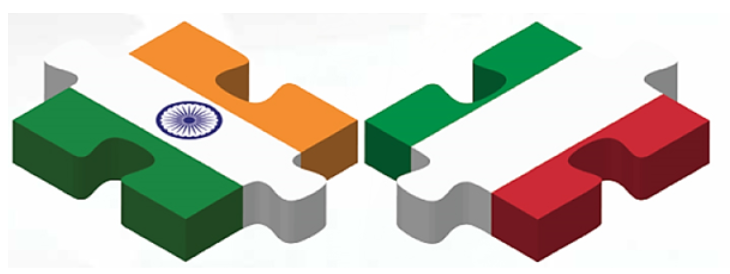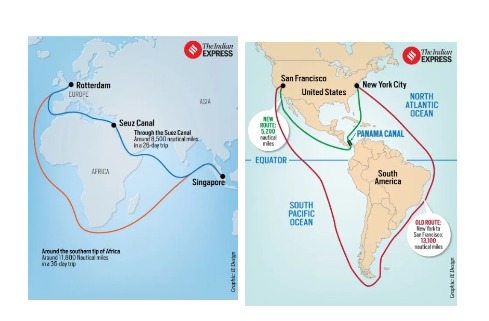Saturday, 6th January 2024
Practice Questions - Current Affairs 06-01-2024
Q 1. Fagradalsfjall volcano was recently erupted, it is located in which of the following countries:
- Indonesia
- USA
- Russia
- Iceland
Q 2. Consider the following regions:
- Circum-Pacific Belt
- Mid-Continental Belt
- Mid Atlantic Ridge
How many of the above are the volcano prone region in the world?
- Only 1
- Only 2
- All three
- None
Q 3. Consider the following statements
Statement-I: Speaker can direct a member to withdraw immediately from the House if he finds the member's conduct disorderly.
Statement-II: A member suspended under rule 374 of Lok Sabha shall forthwith withdraw from the precincts of the House.
Which one of the following is correct in respect of the above statements?
(a) Both Statement-I and Statement-II are correct and Statement- II is the correct explanation for Statement- I
(b) Both Statement-I and Statement-II are correct and Statement- II is not the correct explanation for Statement-I.
(c) Statement-I is correct but Statement-II is incorrect
(d) Statement-I is incorrect but Statement-II is correct
Q 4. Consider the following statements:
- Speaker holds the office during the pleasure of the President.
- Speaker need not be a member of the House at the time of his/her election but has to become a member of the House within six months from the date of his/her election.
- If speaker intends to resign, the letter of his/her resignation has to be addressed to the Deputy Speaker.
How many of the statements given above is/are correct?
(a) Only one
(b) Only two
(c) All three
(d) None
Q 5. Recently, there has been a concern over the short supply of a group of elements called ‘rare earth metals.
- China, which is the largest producer of these elements, has imposed some restrictions on their export.
- Other than China, Australia, Canada and Chile, these elements are not found in any country.
- Rare earth metals are essential for the manufacture of various kinds of electronic items and there is a growing demand for these elements.
How many of the statements given above are correct?
(a) Only one
(b) Only two
(c) All three
(d) None
Q 6. Petaurista petaurista was recently mentioned in the news, it is related to:
- A recently discovered plant species in Arunachal Pradesh
- A species of Squirrel
- A new variety of Ginger
- A purple-coloured mushroom
Q 7. Consider the following:
- Agricultural fields
- Palaeo channels
- Manufactured Sand
How many of the above are the source of Sand in India?
- Only 1
- Only 2
- All three
- None
Q 8. Consider the following statements:
- Sone River is a perennial river in central India, is the Ganges' 2nd-largest southern tributary.
- Sone river only flows through Chhattisgarh, Uttar Pradesh and Bihar.
- Rihand Dam in Uttar Pradesh is built on Sone River.
How many of the statements given above are correct?
(a) Only one
(b) Only two
(c) All three
(d) None
Q 9. Consider the following statements about Particularly Vulnerable Tribal Groups (PVTGs) in India:
- PVTGs reside in 18 States and one Union Territory.
- A stagnant or declining population is one of the criteria for determining PVTG status.
- Odisha has the highest PVTGs in India.
- Jenu and Kathodi tribes are included in the list of PVTGs.
How many of the statements given above is/are correct?
(a) Only one
(b) Only two
(c) Only three
(d) All four
Q 10. Which of the following matters can comes under the adjudication of Tribunals?
- Industrial and labour
- Land reforms
- Ceiling on urban property
- Elections to Parliament and state legislatures
How many of the statements given above is/are correct?
(a) Only one
(b) Only two
(c) Only three
(d) All four
Q 11. Nematocysts are present in which of the following organisms?
- Jellyfish
- Corals
- Sea Anemone
- Starfish
How many of the organism given above are correct?
(a) Only one
(b) Only two
(c) Only three
(d) All four
Q 12. 'State of the Economy' report has been recently released by?
- NITI Aayog
- Reserve Bank of India
- Economic Advisory Council to the Prime Minister of India (PMEAC)
- None
Q 13. Consider the following pairs:
- Censorship under Lord Wellesley - 1829
- Licensing Regulations by John Adams - 1799
- Newspaper (Incitement to Offences) Act - 1908
How many of the above pairs are correctly matched?
(a) Only one
(b) Only two
(c) All three
(d) None
Q 14. Consider the following statements:
- Magnetars are neutron stars having an ultrahigh magnetic field that are much stronger than the terrestrial magnetic field.
- High-energy electromagnetic radiation emitted by magnetars results from the decay of their powerful magnetic fields.
Which of the statements given above is/are not correct?
(a) 1 only
(b) 2 only
(c) Both 1 and 2
(d) Neither 1 nor 2
Q 15. Consider the following protected areas:
- Pakke
- Bhitarkanika
- Nagzira
- Melghat
How many of the above are declared Tiger Reserves?
(a) Only one
(b) Only two
(c) Only three
(d) All four
Q 16. Among the following who are eligible to benefit from the “Mahatma Gandhi National Rural Employment Guarantee Act”?
(a) Adult members of only the scheduled caste and scheduled tribe households
(b) Adult members of below poverty line (BPL) households
(c) Adult members of households of all backward communities
(d) Adult members of any household
Q 17. Which of the following is/are cited by the scientists as evidence/evidence for the continued expansion of the universe?
- Detection of microwaves in space
- Observation of redshift phenomenon in space
- Movement of asteroids in space
- Occurrence of supernova explosions in space
Select the correct answer using the codes given below:
(a) 1 and 2
(b) 2 only
(c) 1, 3 and 4
(d) None
Q 18. Consider the following:
- Service providers
- Data centres
- Body corporate
For how many of the above in India it is legally mandatory to report on cyber security incidents?
- Only 1
- Only 2
- All three
- None
Q 19. Consider the following statements
Statement-I: Participatory Notes are financial instruments used by foreign investors to invest in Indian markets with directly registering with the market regulator.
Statement-II: Participatory Notes are issued by registered foreign institutional investors (FIIs) or their sub-accounts against underlying Indian securities.
Which one of the following is correct in respect of the above statements?
(a) Both Statement-I and Statement-II are correct and Statement- II is the correct explanation for Statement- I
(b) Both Statement-I and Statement-II are correct and Statement- II is not the correct explanation for Statement-I.
(c) Statement-I is correct but Statement-II is incorrect
(d) Statement-I is incorrect but Statement-II is correct
Q 20. Consider the following defence instruments:
- S-400 Triumf
- Kamov Ka-226 200
- T-90S Bhishma
- INS Vikramaditya aircraft carrier programme.
How many of the above military hardware purchased/leased by India from Russia?
(a) Only one
(b) Only two
(c) Only three
(d) All four
Sikki Grass
In News: Sikki artisans suffer economic woes due to climate change, compounded by unmet government commitments for financial aid in setting up Sikki stalls at nationwide trade fairs.

Sikki Grass: Overview
- Botanical Identity
- Sikki grass, belonging to the zizanoides grass family, is a distinctive yellowish reed grass locally known as ‘Kaincha’ and renowned as Golden Grass for its golden sheen upon drying.
- Scientific Classification
- Scientifically termed Chrysopogon zizanioides, Sikki grass has historical references in ancient Sanskrit texts like the Ramayana, where it is mentioned as viran, sugandhimool, ushir, and nalad.
- Natural Habitat
- Indigenous to the Tarai regions of Uttar Pradesh and Bihar, Sikki grass typically grows to an average height of 3-4 feet.
- The stem is utilized for crafting artifacts, while the roots are extracted for oil used in perfumery and medicinal applications.
- In hilly terrains, it is cultivated to prevent soil erosion.
- Geographical Identification
- In 2018, Sikki grass received a geographical identification tag.
- Traditional Uses
- Sikki grass is renowned for its handicraft applications, serving as a livelihood source for many over the ages.
- It is employed in crafting traditional items like multipurpose baskets, ornaments, showpieces, and various utility items highly valued in rural India.
- Current Challenges
- Sikki craftsmen face significant challenges, notably the impact of climate change affecting the grass quality.
- The continuous rise in temperature has led to a decline in grass softness.
- The resultant brittle grass requires additional processing time and proves unsuitable for crafting baskets and other artifacts.
Source: DTE
Aditya L1 to Achieve Final Orbit Placement.
In News: Aditya L1, India's inaugural Sun study mission, approaches its destination, set to enter its ultimate orbit on the evening of January 6.

Aditya-L1 Mission Overview
- About the Mission
- Aditya, meaning "Sun" in Sanskrit, is a meticulously planned coronagraphy spacecraft designed by ISRO and various Indian research institutes.
- Serving as India's inaugural mission dedicated to Sun observation, it was launched aboard a PSLV-XL on September 2, 2023.
- Objectives
- Aditya L1 aims to gather crucial insights into phenomena such as coronal heating, coronal mass ejections, pre-flare and flare activities, and space weather dynamics.
- The spacecraft carries seven payloads to observe different layers of the Sun, utilizing electromagnetic and particle and magnetic field detectors.
- Seven Payloads for Comprehensive Study
- The four remote sensing payloads focus on studying the photosphere, chromosphere, and the outermost layer (corona) of the Sun.
- The remaining three payloads conduct in situ studies of particles and fields at the Lagrange point L1.
Significance of Aditya L1 Mission
- India in the Global Space League
- Aditya L1 marks India's debut in space-based Sun observation. Only NASA and ESA have had spacecraft reach the Lagrange point L1, placing India in an elite league.
- The Need for Space-based Sun Study
- Studying the Sun from space is imperative due to its emissions of various radiations, energetic particles, and magnetic fields across all wavelengths.
- Space-based observations become crucial for a comprehensive understanding as Earth's protective shields don't extend to harmful solar radiation.
- Understanding Space Weather Dynamics
- Solar events influence the weather of the entire solar system, affecting satellite orbits, electronics, and causing disturbances on Earth.
- Aditya L1 contributes to the understanding of space weather, crucial for mitigating potential disruptions.
Lagrange Points Explained
- Lagrange points are positions in space where the gravitational pull of two large masses precisely equals the centripetal force required for a small object to move with them. Spacecraft utilize these points to reduce fuel consumption.
- The L1 point in the Earth-Sun system provides an uninterrupted view of the Sun, hosting the Solar and Heliospheric Observatory Satellite (SOHO).
- Notably, NASA's James Webb Space Telescope occupies the L2 point.
Source: TH
Issue of Indians Jailed Abroad
In News: India, boasting the largest diaspora globally, has over 9,500 of its citizens currently incarcerated in foreign prisons.
Where Most Indian Prisoners Are Incarcerated?
- Total Indians Detained Overseas
- A staggering 9,521 Indians find themselves confined in prisons across 89 out of the 210 countries housing the Indian diaspora.
- Geographical Distribution
- In the Middle East, more than 62% of Indian prisoners are held, with Saudi Arabia leading at 2,200, followed by the United Arab Emirates, Qatar, Kuwait, Bahrain, and Oman.
- In Asia, over 23% of the 1,227 prisoners are in Nepal, followed by Malaysia, Pakistan, China, Singapore, Bhutan, and Bangladesh.
- In Europe, the United Kingdom has the highest number at 278, trailed by Italy, Germany, France, and Spain.
Ensuring the Well-being of Imprisoned Indians Abroad
- Consular Assistance
- Indian Missions and Posts abroad vigilantly monitor incidents involving the detention of Indian nationals for alleged violations of local laws.
- They promptly engage with local authorities to secure consular access, confirm nationality, and ensure the well-being of individuals, offering legal aid and expediting judicial proceedings.
- Government Steps for Assistance
- Under the Indian Community Welfare Fund (ICWF), support includes financial aid for legal assistance and facilitating repatriation.
- Efforts for release and repatriation include seeking pardon or sentence reduction, pursuing Transfer of Sentenced Persons (TSP) agreements with 31 countries, and adhering to multilateral conventions on sentence transfer.
The Path Forward: Addressing Challenges and Strengthening Support
- Enhancing Consular Assistance
- Strengthening the resources and capabilities of Indian missions abroad to consistently provide robust consular assistance is imperative.
- Awareness and Outreach
- Creating awareness among the Indian diaspora about local laws and customs through outreach programs or information campaigns can help prevent legal issues.
- Diplomatic Efforts
- Intensifying diplomatic efforts and negotiations with other countries is essential for streamlining the process of transferring prisoners and ensuring fair treatment for Indian nationals in foreign jails.
- Policy Review
- Continuously reviewing and updating policies related to Indian nationals imprisoned abroad, including potential amendments to existing agreements or the creation of new ones, can facilitate smoother repatriation or sentence transfers.
Source: IE
Liquid Nano Urea
In News: Scientists from Punjab Agricultural University (PAU) conducted a two-year field experiment to assess the effectiveness of Liquid Nano Urea.
Understanding Liquid Nano Urea: A Breakdown
- Overview
- Liquid Nano Urea is a nanoparticle-based form of urea, functioning as a liquid nutrient to supply nitrogen to plants as an alternative to traditional urea fertilizers. This white chemical nitrogen fertilizer has been developed to replace conventional urea, aiming to reduce the necessity for the latter by at least 50%.
- Composition and Launch
- Containing 40,000 mg/L of nitrogen in a 500 ml bottle, Liquid Nano Urea was launched in June 2021 by the Indian Farmers and Fertiliser Cooperative (IFFCO). Developed at the IFFCO-Nano Biotechnology Research Centre in Kalol, Gujarat, this innovation aligns with the principles of Atmanirbhar Bharat and Atmanirbhar Krishi, aiming for self-reliance in agriculture.
- Application Method
- Designed as a foliar spray, this fertilizer is intended for use once leaves have appeared on the crops.
Key Insights into the Effectiveness of Liquid Nano Urea
- Yield Impact
- The field experiment conducted by scientists from Punjab Agricultural University revealed a substantial reduction in crop yields when Liquid Nano Urea was employed, indicating a 21.6% decrease in wheat yield and a 13% decrease in rice yield compared to conventional nitrogen fertilizers.
- Grain Nitrogen Content
- The application of Liquid Nano Urea resulted in diminished grain nitrogen content for both rice and wheat crops, showcasing a 17% and 11.5% decrease, respectively.
- The lowered grain nitrogen content raises concerns about reduced protein levels in staple foods like rice and wheat, impacting protein energy requirements in a country like India.
- Cost Considerations
- Despite its potential benefits, the cost of the nano urea formulation is notably higher, approximately 10 times more than that of granular urea.
- This cost factor adds to the overall cultivation expenses for farmers.
- Crop Biomass and Root Volume
- Interestingly, the application of Liquid Nano Urea led to a reduction in above-ground biomass and root volume.
- This decrease in root volume has implications for nutrient uptake processes, affecting the overall health and growth of the crops.
|
UPSC Previous Year Questions Prelims (2020) Q. With reference to chemical fertilizers in India, consider the following statements:
Which of the statements given above is/are correct? (a) 1 only Ans: (b) Exp:
|
Source: DTE
Biodiversity Credits
In News: Biodiversity Credits, financial mechanism to support initiatives aimed at achieving the targets outlined in the Kunming-Montreal Global Biodiversity Framework (KMGBF).
Understanding Biodiversity Credits
- Overview
- Biodiversity credits represent a financial instrument designed to secure funds for the conservation, restoration, and sustainable utilization of areas rich in biodiversity.
- Distinct from Carbon Credits, they aim to attract private investments toward initiatives aligned with international agreements like the Kunming-Montreal Global Biodiversity Framework (KMGBF) under the CBD.
- Biodiversity Credit Alliance
- Launched at CoP15 of CBD and further discussed at CoP28 of UNFCCC in December 2023, the Biodiversity Credit Alliance seeks to mobilize support and raise awareness among governmental bodies, non-profits, and private enterprises for promoting biodiversity credits.
- Implementation and Initiatives
- Ocean Conservation Commitments (OCCs), introduced in September 2023, are linked to Niue's Moana Mahu Marine Protected Area.
- Priced at USD 148 per OCC, they attract investments from organizations like the Blue Nature Alliance and Conservation International.
- The Wallacea Trust, a UK-based organization, has committed 5 million biodiversity credits, signaling interest from research-oriented entities.
Challenges and Uncertainties
- Despite their potential, challenges surround the success of biodiversity credits.
- Regulatory frameworks, fair pricing structures, and ensuring genuine conservation impact rather than corporate interests are crucial considerations.
Navigating the Path Forward for Biodiversity Credits
- Optimizing Regulation and Monitoring
- To harness the potential of biodiversity credits, urgent attention is required to establish effective regulatory and monitoring mechanisms.
- Ensuring fair pricing for both sellers and buyers is integral to their success.
- Leadership in Market Integrity
- The governments of the United Kingdom and France are pioneering efforts to create a roadmap for a high-integrity biodiversity credits market.
- This initiative acknowledges the complexity of balancing private sector interests with genuine biodiversity conservation goals.
- Addressing Corporate Interests
- Given the private sector's involvement in promoting biodiversity credits, there is a need to navigate potential conflicts of interest.
- Prioritizing biodiversity over corporate interests requires careful consideration and vigilant implementation.
|
UPSC Previous Year Questions Prelims (2023) Q. Consider the following statements:
Which of the statements given above is/are correct? (a) 1 only Ans: (c) Exp:
|
Source: DTE
Buxa Tiger Reserve
In News: After 23 years of absence, a tiger has returned to West Bengal's Buxa Tiger Reserve (BTR) for the second time in two years, raising hopes for an ecosystem revival and a possible resurgence of tiger populations.

Key Facts About Buxa Tiger Reserve
- Overview
- Covering 760 square kilometers, Buxa Tiger Reserve and National Park are situated in North Bengal's Alipurduar district.
- Classified as a "low density" reserve, it forms part of a larger tiger territory extending into Bhutan.
- Corridor Connectivity
- Recognized by the National Tiger Conservation Authority (NTCA), Buxa Reserve boasts corridor connectivity with Bhutan's forests in the North, links to the Kochugaon forests (Assam) and Manas Tiger Reserve (Assam) in the East, and connectivity with Jaldapara National Park in the West.
- These connections play a crucial role in promoting Bengal tiger migration and genetic diversity.
- Rich Flora
- Diverse tree species, including Sal, Champ, Gamar, Simul, and Chikrasi, contribute to the vibrant ecosystem of the reserve.
- Abundant Fauna
- The reserve is home to diverse wildlife, including the Asian Elephant, Tiger, gaur (Indian bison), Wild boar, Sambar, and Wild dog (Dhole).
- Endangered species such as the Leopard cat, Bengal florican, Regal python, Chinese Pangolin, Hispid hare, and Hog deer are also found in Buxa.
- Conservation Initiatives
- Conservation efforts in Buxa Tiger Reserve involve strategic interventions, including the introduction of chitals (spotted deer) to enhance the tiger's prey base.
- Initiatives focus on expanding grasslands, minimizing human interference, controlling infiltration, and fostering harmonious coexistence between humans and wildlife.
- Tiger Augmentation Project
- Launched in 2018, the Tiger Augmentation Project is a collaborative effort between the state forest department, the Wildlife Institute of India, and the NTCA.
- This project aims to monitor and enhance the tiger population in Buxa Tiger Reserve.
Source: IE
Similipal Kai Chutney
In News: The geographical identity tag has been granted to Similipal Kai Chutney, a condiment made with red weaver ants by the tribal communities in Mayurbhanj district of Odisha.

Similipal Kai Chutney
- An Overview
- Similipal Kai Chutney, renowned in the Mayurbhanj region for its therapeutic attributes, holds significance in ensuring the nutritional well-being of tribal communities.
- Indigenous Collection
- Indigenous populations in Mayurbhanj district venture into nearby forests to gather kai pimpudi, the red weaver ants, a practice that sustains approximately 500 tribal families engaged in collecting and selling these insects, and crafting a unique chutney from them.
- Health Benefits
- Upon analysis, scientists have identified valuable components in red weaver ants, including proteins, calcium, zinc, vitamin B-12, iron, magnesium, potassium, sodium, copper, and amino acids.
- Consumption of this species is believed to enhance the immune system and act as a preventive measure against various diseases.
- Traditional Healing Practices
- Tribal healers prepare a medicinal oil by immersing the red weaver ants in pure mustard oil.
- After a month, this infusion serves as a body oil for infants and is utilized for treating conditions such as rheumatism, gout, ringworm, and other ailments within the tribal communities.
- Local residents also consume this concoction for overall well-being and strength.
Source: DTE
PRERANA Program
In News: The Ministry of Education, Government of India, through the Department of School Education & Literacy, has recently introduced 'Prerana: An Experiential Learning Program.'
About the PRERANA Program
- The PRERANA program is designed to provide a meaningful and inspiring experience to participants, focusing on nurturing leadership qualities.
- Rooted in the principles of the Indian education system and the values outlined in the National Education Policy (NEP) 2020, it is a week-long residential initiative for selected students from classes IX to XII.
Program Location and Structure
- Conducted in Vadnagar, Gujarat, at one of India's oldest Vernacular Schools established in 1888, the program hosts a batch of 20 students weekly, comprising 10 boys and 10 girls from different parts of the country.
- The curriculum, developed by IIT Gandhi Nagar, revolves around nine value-based themes, emphasizing principles such as Swabhiman, Vinay, Shaurya, Sahas, Parishram, Samarpan, Karuna, Sewa, Vividhta, Ekta, Satyanishtha, Shuchita, Navachar, Jigyasa, Shraddha, Vishwas, and Swatantrata, Kartavya.
Daily Schedule and Activities
- The day-wise schedule includes yoga, mindfulness, and meditation sessions, along with experiential learning, thematic discussions, and engaging hands-on activities.
- Evening activities encompass visits to ancient and heritage sites, inspirational film screenings, creative missions, talent shows, ensuring a holistic learning approach.
Diverse Learning Approach
- PRERANA encourages students to explore indigenous knowledge systems, embrace state-of-the-art technologies, and learn from inspirational personalities, fostering a diverse and enriching learning experience.
Selection Process
- Students can register through the portal, providing necessary details.
- The selection process, as outlined on the portal, includes participation in 'Prerana Utsav' day activities conducted at the school/block level.
Source: PIB
Graphene
In News: Researchers have achieved a groundbreaking milestone by developing the world's first functional semiconductor using graphene.

About Graphene
- Graphene is a single-layer arrangement of carbon atoms forming a hexagonal lattice, measuring just one atom thick. Serving as the foundational structure for Graphite, commonly used in pencil tips, it was initially isolated in 2004.
- Properties
- Graphene stands as the thinnest material globally, being one million times thinner than human hair.
- Despite its thinness, it exhibits remarkable strength, surpassing that of steel and diamond.
- Exceptional conductivity for heat and electricity, outperforming copper.
- Nearly perfect transparency, absorbing only 2% of light.
- Impermeability to gases, including light ones like hydrogen and helium.
- Applications
- Mechanical Strength
- Enhances the strength of various materials.
- Thermal Applications
- Ideal for heat-spreading solutions, such as heat sinks or dissipation films, benefiting microelectronics and larger applications like thermal foils for mobile devices.
- Energy Storage
- With an incredibly high surface-area-to-volume ratio, graphene holds promise for batteries and supercapacitors, offering enhanced energy storage and faster charging capabilities.
- Mechanical Strength
- Versatile Potential
- Graphene exhibits potential applications in anti-corrosion coatings, precise sensors, efficient electronics, flexible displays, solar panels, DNA sequencing, drug delivery, and more.
- Its properties open avenues for innovation across various fields.
Source: LM
Aspergillus fumigatus
In News: A group of international researchers has recently disclosed groundbreaking findings related to the fungus Aspergillus fumigatus, known for its potential to cause deadly diseases in humans.

About Aspergillus fumigatus
- Aspergillus fumigatus is a fungus species known for causing diseases in humans, prevalent in various environments such as soil, plant matter, and household dust.
- The fungus generates airborne spores called conidia, with individuals often inhaling these spores on a daily basis.
- While a healthy immune system can typically clear them, inhaling A. fumigatus spores can lead to severe infections in some cases.
Opportunistic Nature
- Considered an opportunistic organism, A. fumigatus exhibits low virulence and causes diseases primarily under specific circumstances:
- Severe physical debilitation due to illness, malnutrition, advanced age, etc.
- Immunosuppression caused by diseases or medications.
- Utilization of implants, such as prosthetic devices.
Illness Caused
- Infections caused by Aspergillus species are termed as aspergillosis. This can manifest as allergic reactions, chronic lung conditions, or invasive diseases affecting organs like the brain, kidneys, and lungs.
Symptoms
- Symptoms of aspergillosis vary based on the type and location in the body. Common symptoms include coughing (potentially with blood), shortness of breath, wheezing, chest pain, fever, and, in chronic cases, fatigue and weight loss.
Treatment
- Treatment approaches involve a combination of surgery and antifungal medications, addressing the specific manifestation of aspergillosis in the affected individual.
Source: PO
Polygonum Chaturbhujanum
In News: A survey conducted at Gol Pahadi Island in the Pench Tiger Reserve (PTR) in Maharashtra has led to the discovery of a new plant species belonging to the Polygonum genus.

New Plant Discovery: Polygonum Chaturbhujanum
- A recent botanical exploration at Gol Pahadi island within the Pench Tiger Reserve (PTR) has led to the discovery of a new herbaceous plant species named Polygonum Chaturbhujanum.
Six Endemic Indian Plant Species in Pench
- Aegineta indica
- Boerhavia crispa
- Habenaria gibsonii var foetida
- Iphigenia pallida
- Petalidium barlerioides
- Barleria gibsoniii
Pench Tiger Reserve: Key Facts
- Location: Situated in the southern stretches of the Satpura hills, spanning Seoni and Chhindwara districts in Madhya Pradesh, and extending into Nagpur district in Maharashtra as a separate Sanctuary.
- Naming: Named after the Pench River, flowing from north to south through the Reserve.
- Components: Comprises the Indira Priyadarshini Pench National Park, the Pench Mowgli Sanctuary, and a buffer zone.
- Terrain: Characterized by undulating landscapes, featuring small hills and steep slopes.
- Vegetation: Exhibits diverse vegetation, ranging from moist, sheltered valleys to open, dry-deciduous forests.
- Flora: Encompasses species like teak, saag, mahua, various grasses, and shrubs.
- Fauna: Rich biodiversity includes chital, sambar, nilgai, gaur (Indian Bison), wild boar, tiger, dogs, and wolf.
Source: TOI
The dispute on India’s debt burden
In News: A recent article addresses concerns related to debt sustainability and advocates for a cautious approach to managing public debt in India.
Key Observations from the IMF Report
- Concerns on Debt Sustainability in India
- The IMF report raises concerns about the long-term sustainability of India's debts, projecting that government debt could reach 100% of GDP by 2028 under adverse circumstances.
- Reclassification of India's Exchange Rate Regime
- The IMF has reclassified India's exchange rate regime from "floating" to a "stabilised arrangement," indicating a shift in how India manages its currency.
- In a stabilised arrangement, the government fixes the exchange rate, unlike a floating system determined by market forces.
- High Long-Term Risks in Debt Management
- The report highlights high long-term risks in debt management, particularly in meeting India’s climate change mitigation targets, requiring substantial investments.
Understanding Public Debt
- Definition
- Public debt refers to the total amount of money that a government owes to external creditors and domestic lenders, including obligations from the Union government settled using funds from the Consolidated Fund of India.
- Types
- External Debt
- Owed to foreign creditors.
- Internal Debt
- Owed to lenders within the country, further categorized into marketable and non-marketable securities.
- External Debt
- Objectives of Public Debt
- Financing Government Expenditure
- Provides stable funding during budget deficits.
- Stabilizing the Economy
- Used as a counter-cyclical measure during economic downturns.
- Managing Liquidity
- Controls money supply and interest rates.
- Financing Development Plans
- Funds critical infrastructure projects for economic development.
- Measuring Mechanisms
- Public debt is expressed as the debt-to-GDP ratio, indicating the debt burden relative to the size of the economy.
- Financing Government Expenditure
Key Concerns for Public Debt Management in India
- Burgeoning Public Debt Levels
- India's public debt-to-GDP ratio has increased slightly, reaching 84% in 2021-22. Interest payments are high, exceeding spending on vital sectors like education and healthcare.
- High-Interest Payments
- Interest payments, exceeding 5% of GDP and 25% of revenue receipts on average, impact government spending priorities.
- Limitations on Fiscal Policy
- High public debt levels may limit the government's capacity for counter-cyclical fiscal measures during economic downturns.
- Lower Credit Ratings
- Persistently high deficits and debt levels may lead to lower sovereign ratings, increasing the cost of external borrowing.
- Misuse of Public Money
- Corruption and bureaucratic hurdles may lead to the misuse of public funds, raising concerns about intergenerational equity.
- Crowding Out Private Investment
- Large government borrowings may crowd out private investment, impacting economic growth.
- Financial System Risks
- A high concentration of debt in the financial system poses systemic risks affecting overall stability.
Way Forward
- Prudential Stance
- Achieve fiscal consolidation, following recommendations like the NK Singh Committee's debt-to-GDP ratio targets.
- Encourage fiscal reforms at the state level for prudent fiscal policies.
- Raise Additional Revenue
- Improve tax collection and compliance through administrative streamlining.
- Pursue disinvestment and strategic asset management for optimal resource utilization.
- Re-orient Spending
- Prioritize investments in infrastructure, human capital, and green initiatives.
- Consider privatization of loss-making PSUs and explore PPP models for social schemes.
- Utilize Institutional Mechanisms
- Leverage the PFMS for effective fiscal deficit management.
- Establish a Public Debt Management Agency (PDMA) for specialized and focused debt management.
Conclusion
India should focus on building a financially prudent, transparent, and sustainable environment, addressing concerns raised in the IMF report while dismissing projections as a 'worst-case scenario.'
|
UPSC Previous Year Questions Prelims (2018) Q. Consider the following statements:
Which of the statements given above is/are correct? (a) 1 only Ans: C Mains (2019) Q. Public expenditure management is a challenge to the Government of India in the context of budget-making during the post-liberalization period. Clarify it. |
Source: TH
Share the article
Edukemy’s Current Affairs Quiz is published with multiple choice questions for UPSC exams
MCQ
Get Latest Updates on Offers, Event dates, and free Mentorship sessions.

Get in touch with our Expert Academic Counsellors 👋
FAQs
UPSC Daily Current Affairs focuses on learning current events on a daily basis. An aspirant needs to study regular and updated information about current events, news, and relevant topics that are important for UPSC aspirants. It covers national and international affairs, government policies, socio-economic issues, science and technology advancements, and more.
UPSC Daily Current Affairs provides aspirants with a concise and comprehensive overview of the latest happenings and developments across various fields. It helps aspirants stay updated with current affairs and provides them with valuable insights and analysis, which are essential for answering questions in the UPSC examinations. It enhances their knowledge, analytical skills, and ability to connect current affairs with the UPSC syllabus.
UPSC Daily Current Affairs covers a wide range of topics, including politics, economics, science and technology, environment, social issues, governance, international relations, and more. It offers news summaries, in-depth analyses, editorials, opinion pieces, and relevant study materials. It also provides practice questions and quizzes to help aspirants test their understanding of current affairs.
Edukemy's UPSC Daily Current Affairs can be accessed through:
- UPSC Daily Current Affairs can be accessed through Current Affairs tab at the top of the Main Page of Edukemy.
- Edukemy Mobile app: The Daily Current Affairs can also be access through Edukemy Mobile App.
- Social media: Follow Edukemy’s official social media accounts or pages that provide UPSC Daily Current Affairs updates, including Facebook, Twitter, or Telegram channels.






